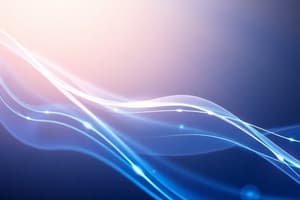Podcast
Questions and Answers
Which statement explains the student's observations with the glasses of water producing different pitches?
Which statement explains the student's observations with the glasses of water producing different pitches?
- The amount of water in the glass affects vibration rate. (correct)
- Some of the glasses were tapped harder with the spoon.
- The tapping creates different sounds that echo.
- Sound travels faster through larger amounts of water.
How will the sound of students' voices change if the classroom is filled with soft objects?
How will the sound of students' voices change if the classroom is filled with soft objects?
- The sounds will become quieter. (correct)
- The sounds will combine.
- The sounds will travel more slowly.
- The sounds will have a higher pitch.
Why do the sounds of the students' voices change after the classroom is filled with soft objects?
Why do the sounds of the students' voices change after the classroom is filled with soft objects?
- The objects absorb the sound vibrations that reach them. (correct)
- The objects move when the sound vibrations reach them.
- The objects cause sound vibrations to bounce back.
- The objects allow sound vibrations to pass through them.
What colors make up sunlight?
What colors make up sunlight?
What is the aim of the student's method to increase the temperature of water?
What is the aim of the student's method to increase the temperature of water?
What is being investigated by the student with identical water glasses?
What is being investigated by the student with identical water glasses?
What needs to be clicked on to produce a pitch lower than that of Glass A?
What needs to be clicked on to produce a pitch lower than that of Glass A?
Flashcards
Water Level vs. Pitch
Water Level vs. Pitch
The amount of water alters the glass's vibration frequency, thus changing the pitch.
Sound in a Soft Room
Sound in a Soft Room
The sounds will be less intense due to absorption.
Sound Absorption
Sound Absorption
Soft materials reduce sound reflection, absorbing the sound wave's energy.
Colors of Sunlight
Colors of Sunlight
Signup and view all the flashcards
Heat Absorption Experiment Aim
Heat Absorption Experiment Aim
Signup and view all the flashcards
Pitch Variation Investigation
Pitch Variation Investigation
Signup and view all the flashcards
Lower Pitch Selection
Lower Pitch Selection
Signup and view all the flashcards
Study Notes
Light Reflection and Color
- Different colors of light reflect off surfaces differently; an apple reflects specific wavelengths that correspond to its observed color.
- The flower appears blue in sunlight because it reflects blue light while absorbing other colors in the spectrum.
Sound and Vibration
- The pitch of sound varies based on the amount of water in a glass; more water typically leads to a lower pitch due to slower vibration rates.
- Tapping glasses with different water levels causes distinct sounds, illustrating the relationship between sound pitch and water volume.
Sound Acoustics in Environments
- In a space filled with soft objects, sounds become quieter because soft materials absorb sound vibrations, reducing echo.
- The inclusion of soft objects alters the acoustics by allowing sound waves to dissipate rather than bounce back.
Heat Absorption
- The method for increasing water temperature involves selecting materials that absorb heat efficiently; cups and lamps are analyzed for their heat absorption potential.
- Proper selection of equipment can significantly influence the temperature increment of water in a controlled experiment.
Investigating Pitch Variation
- In experiments to determine sound pitch, varying the water level in glasses allows students to predict changes in pitch based on recorded vibration rates from different setups.
- Lower water levels typically correspond to higher pitches, while increasing water volume can produce lower pitches, showcasing a practical application of sound principles.
Studying That Suits You
Use AI to generate personalized quizzes and flashcards to suit your learning preferences.




